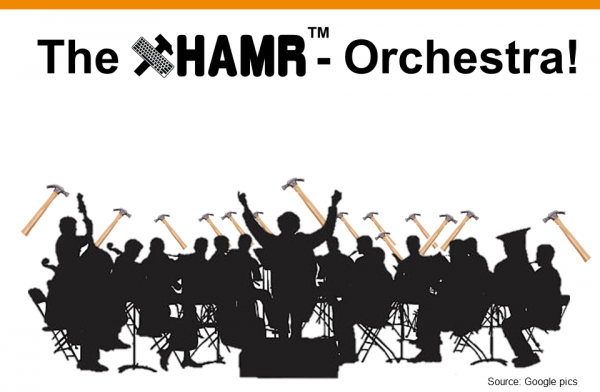User Tools
hamr-orchestra
Table of Contents
HAMR-Orchestra
| Authors | Frank Zalkow frank.zalkow@audiolabs-erlangen.de, Christof Weiß christof.weiss@audiolabs-erlangen.de |
| Affiliation | International Audio Laboratories Erlangen |
| Code | Github TSM toolbox |
A HAMR-Orchestra is an orchestral sound having the attack sound of a piano (German: HAMMERklavier).

Method
- Needed: Recordings of orchestral and piano version of same composition.
- Use music synchronization to get an alignment between both recordings1).
- Use non-linear time stretching to stretch one recording to be synchronous with the other one2).
- Use Harmonic-Percussive-Residual Separation to separate both in recordings into three components each3).
- Mix the harmonic component of the orchestral version and the percussive component of the piano recoding. Ignore the residual components, since they contain mainly artifacts. Possibly, applying a bit of compression can improve the balance between the two parts.
- You got your HAMR-Orchestra!

Example – Ludwig van Beethoven: Symphony No. 5 in C minor Op. 67
| Original piano version | Lambis Vassiliadis (piano), Public Domain Musopen) | |
| Original orchestral version | Simon Schindler (conductor), Fulda Symphonic Orchestra, CC BY-SA 3.0 IMSLP) | |
| Time-stretched piano version | CC BY-SA 4.0 | |
| Harmonic component of orchestral version | CC BY-SA 4.0 | |
| Percussive component of time-stretched piano | CC BY-SA 4.0 | |
| HAMR-Orchestra | CC BY-SA 4.0 |
1)
Meinard Müller: Fundamentals of Music Processing – Audio, Analysis, Algorithms, Applications, Springer Verlag 2015.
2)
Jonathan Driedger and Meinard Müller: A Review on Time-Scale Modification of Music Signals, Applied Sciences, 6(2): 57–82, 2016.
3)
Jonathan Driedger, Meinard Müller and Sascha Disch: Extending Harmonic-Percussive Separation of Audio Signals, Proceedings of the International Conference on Music Information Retrieval (ISMIR): 611–616, 2014.
hamr-orchestra.txt · Last modified: 2017/10/22 17:26 by fzalkow

